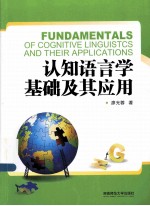图书介绍
认知语言学基础及其应用 英文PDF|Epub|txt|kindle电子书版本网盘下载

- 廖光蓉著;白解红审定 著
- 出版社: 长沙:湖南师范大学出版社
- ISBN:9787564818777
- 出版时间:2014
- 标注页数:299页
- 文件大小:38MB
- 文件页数:315页
- 主题词:认知科学-语言学-研究-汉、英
PDF下载
下载说明
认知语言学基础及其应用 英文PDF格式电子书版下载
下载的文件为RAR压缩包。需要使用解压软件进行解压得到PDF格式图书。建议使用BT下载工具Free Download Manager进行下载,简称FDM(免费,没有广告,支持多平台)。本站资源全部打包为BT种子。所以需要使用专业的BT下载软件进行下载。如BitComet qBittorrent uTorrent等BT下载工具。迅雷目前由于本站不是热门资源。不推荐使用!后期资源热门了。安装了迅雷也可以迅雷进行下载!
(文件页数 要大于 标注页数,上中下等多册电子书除外)
注意:本站所有压缩包均有解压码: 点击下载压缩包解压工具
图书目录
Part Ⅰ Views,commitments,foundations and assumptions1
1 Views and commitments2
1.1 Three views2
1.1.1 Experiential view2
1.1.2 Prominent view3
1.1.3 Attentional view4
1.2 Two commitments4
2 Foundations and assumptions6
2.1 Foundations6
2.1.1 Sensation and perception6
2.1.2 Types of experience6
2.1.3 Cognition and cognitive economy7
2.2 Assumptions of language8
Part Ⅱ Concept and category11
3 Conceptualization,concept and concept structure12
3.1 Conceptualization and concept12
3.1.1 Conceptualization12
3.1.2 Concept14
3.2 Conceptual structure15
3.2.1 Definition16
3.2.2 What does conceptual structure look like?16
3.2.3 Conceptual structure and semantic structure17
4 Categorization and prototype category20
4.1 Categorization20
4.1.1 Definitions20
4.1.2 Principles,rules and operation of categorization21
4.1.3 Functions24
4.1.4 Two dimensions25
4.2 Prototype category25
4.2.1 Family resemblance25
4.2.2 Definitions of prototype category26
4.2.3 Fuzziness of prototype category27
4.2.4 Types of categories27
4.2.5 Attribute structure of prototype category28
4.2.6 Prototype28
4.2.7 Basic-level category33
4.2.8 Problems with prototype category theory35
4.3 Concept and category36
Part Ⅲ Theories of conceptual knowledge structures38
5 Image schem40
5.1 Image and schema40
5.2 Image schema40
5.2.1 Definitions of image schema41
5.2.2 Classification of image schema42
5.2.3 Properties of image schema42
5.2.4 An inventory of image schemas43
5.2.5 Illustration of some image schemas44
5.3 Limitations48
6 Cognitive model and cultural model50
6.1 Culture50
6.1.1 Definitions from the cognitive perspective50
6.1.2 Classifications51
6.1.3 Attributes and characteristics52
6.2 Cognitive model and idealized cognitive model53
6.2.1 Definitions and characteristics of cognitive model53
6.2.2 Definitions and principles of idealized cognitive model55
6.3 Cultural model55
6.3.1 Definition56
6.3.2 Two types56
6.4 Connection and distinction of cultural model and cognitive model56
6.5 Major influences of culture on cognition57
7 Frame and domain59
7.1 Frame59
7.1.1 Definitions59
7.1.2 Two basic components62
7.1.3 Event frame62
7.1.4 Speech event frame63
7.2 Conceptual domain64
7.2.1 Definition64
7.2.2 Classification65
7.2.3 Connection and distinction between image schema and basic domain66
7.2.4 Two more characteristics of domain68
7.2.5 Profile and base organisation69
7.2.6 Active zones71
7.3 Connection and distinction of Fillmore's theory of frame semantics and Langacker's theory of domain72
8 Encyclopedic knowledge network and formal unit concept frame75
8.1 Encyclopedic knowledge network75
8.1.1 Basis of encyclopedic semantics75
8.1.2 Definition of encyclopedic knowledge network75
8.1.3 Types of encyclopedic knowledge76
8.1.4 Four continua78
8.1.5 Conventionality versus non-conventionality78
8.1.6 Influences of the types of encyclopedic knowledge upon centrality79
8.1.7 Distinction between encyclopedic meaning and contextual meaning79
8.2 Formal unit concept frame80
8.2.1 Conceptual segmentation81
8.2.2 Lexical concept and formal unit concept81
8.2.3 Definition of formal unit concept frame81
8.2.4 Application fields81
8.3 The connection and distinction between the two guys82
8.3.1 Connection82
8.3.2 Distinction83
9 Mental space85
9.1 Definitions85
9.2 Complex relationship between language and cognition86
9.3 Meaning construction89
9.3.1 General introduction89
9.3.2 The architecture of the process of meaning construction90
9.3.3 Dynamic nature of meaning construction95
Part Ⅳ Theories of cognitive operations96
10 Conceptual metaphor98
10.1 Resemblance metaphor98
10.1.1 Schematic form98
10.1.2 Basis98
10.1.3 Definition99
10.1.4 Image metaphor99
10.2 Conceptual metaphor99
10.2.1 Focus and significance100
10.2.2 Definitions101
10.2.3 Most common target and source domains and their characteristics102
10.2.4 Metaphorical entailments104
10.2.5 Conceptual metaphor system105
10.2.6 Conceptual metaphor and image schema106
10.2.7 Characteristics109
10.2.8 Major problems111
11 Conceptual metonymy113
11.1 Definitions113
11.1.1 By Lakoff&Johnson(1980)113
11.1.2 By Langacker(1993)113
11.1.3 By K?vecses&Radden(1998)113
11.1.4 By Croft(1993)114
11.1.5 By Croft&Cruse(2004:48)114
11.1.6 By Evans&Green(2006:314)114
11.1.7 By Panther(2006)114
11.1.8 Conclusion115
11.2 Classification115
11.2.1 Part-whole/whole-part relationship116
11.2.2 Part-part relationships118
11.2.3 Simple and compound metonymy122
11.3 Properties and characteristics123
11.3.1 Properties123
11.3.2 Characteristics124
11.4 Cognitive principles for selection of a source/vehicle124
11.5 Differences between conceptual metaphor and metonymy125
11.5.1 Metonymy represented by the formula B for A125
11.5.2 Metonymy functioning as a reference differently from metaphor126
11.5.3 Metonymy motivated by physical or causal associations126
11.5.4 Metonymy:not a cross-domain mapping127
12 Conceptual blending128
12.1 Objective of conceptual blending theory128
12.2 Network of conceptual blending130
12.2.1 Illustration of the basic network of conceptual blending130
12.2.2 Difference between mental space and conceptual domain132
12.2.3 Composition of integration network133
12.2.4 Kinds of integration network134
12.2.5 Application to a non-linguistic example of meaning construction138
12.3 Constitutive processes and consequences139
12.4 Goals of conceptual blending achieved by compressing140
12.4.1 Vital relations141
12.4.2 Types of vital relations and their compressions142
12.4.3 Disintegration and decompression147
12.5 Multiple blending147
12.6 Constraints on the theory149
12.6.1 Governing principles149
12.6.2 Brief discussion of two principles151
12.7 Identification and complementation of conceptual blending theory and conceptual metaphor theory151
12.7.1 Identification151
12.7.2 Complementation152
Part Ⅴ Cognitive approaches to form and meaning154
13 Talmy's approach to grammar158
13.1 Grammatical meaning is schematic159
13.2 Primary basic domains and conceptual alternativity161
13.2.1 SPACE and TIME domains161
13.2.2 Conceptual alternativity162
13.3 Conceptual structuring system163
13.3.1 Configurational structure system164
13.3.2 Attentional system169
13.3.3 Perspectival system171
13.3.4 Force-dynamics system173
14 Langacker's approach to grammar175
14.1 Conceptual basis of word classes175
14.1.1 Nominal predication176
14.1.2 Relational predication177
14.2 Attention178
14.2.1 Selection:profiling179
14.2.2 Perspective:trajector-landmark organisation and deixis183
14.2.3 Abstraction:profiling186
14.3 Force-dynamics187
14.4 Categorization and polysemy in grammar:the network conception188
15 Construction grammar191
15.1 Construction191
15.1.1 Definitions191
15.1.2 Properties192
15.1.3 Similarities and differences between the definitions of Langacker and Goldberg192
15.2 Constructional approaches to grammar developed within cognitive linguistics193
15.2.1 Construction grammar by Goldberg193
15.2.2 Croft's approach210
15.2.3 Embodied construction grammar by Bergen&Chang211
15.3 Comparison among constructional approaches to grammar212
16 Grammaticalisation215
16.1 General introduction215
16.1.1 Definition215
16.1.2 Nature215
16.1.3 Renewal process216
16.1.4 Patterns219
16.2 Three cognitive theories of grammaticalisation219
16.2.1 Metaphorical extension approach219
16.2.2 Invited inferencing theory224
16.2.3 Langacker's subjectification approach228
16.3 Comparison among the approaches:taking be going to as an example230
Appendix 1 Referential key points of the answers to the pre-lecture questions233
Appendix 2 Referential key points of the answers to the in-lecture questions250
Appendix 3 Instances of students'after-lecture research practices277
References293
后记299